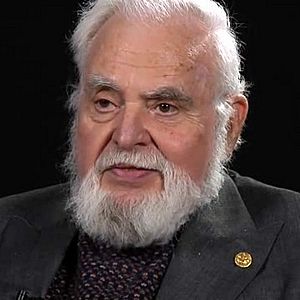Solomon W. Golomb facts for kids
Quick facts for kids
Solomon W. Golomb
|
|
|---|---|
 |
|
| Born |
Solomon Wolf Golomb
May 30, 1932 |
| Died | May 1, 2016 (aged 83) Los Angeles, California, US
|
| Nationality | American |
| Alma mater | Harvard University |
| Awards | Claude E. Shannon Award (1985) IEEE Richard W. Hamming Medal (2000) National Medal of Science (2011) |
| Scientific career | |
| Fields | Mathematics, engineering |
| Institutions | University of Southern California |
| Doctoral advisor | David Widder |
Solomon Wolf Golomb (May 30, 1932 – May 1, 2016) was an American mathematician and engineer. He was also a professor of electrical engineering at the University of Southern California. He is best known for his work on mathematical games and puzzles.
In 1948, he invented a game called Cheskers. This game was a mix of chess and checkers. He also came up with the names for polyominoes and pentominoes in 1953. These are shapes made by connecting squares. His work on pentominoes later helped inspire the famous video game Tetris. Golomb was an expert in areas like combinatorial analysis, number theory, and coding theory.
Contents
Early Life and Studies
Solomon Golomb went to Baltimore City College for high school. He then earned his first degree from Johns Hopkins University. Later, he received his master's and doctorate degrees in mathematics from Harvard University in 1957. His doctorate paper was about "Problems in the Distribution of the Prime Numbers."
Career and Discoveries
After his studies, Golomb worked at the Glenn L. Martin Company. There, he became very interested in how we send and receive information, known as communications theory. He started working on special number patterns called shift register sequences.
He spent a year studying at the University of Oslo in Norway. Then, he joined the Jet Propulsion Laboratory at Caltech. At Caltech, he researched communications for military and space uses. In 1963, he joined the USC as a professor. He became a full professor two years later.
Pseudorandom Sequences
Golomb was a leader in understanding special sequences of numbers. These are called maximum length shift register sequences. They are also known as pseudorandom or pseudonoise sequences. These sequences look random but are actually created by a rule. They are very useful in many areas. For example, millions of cordless and cellular phones today use these sequences. They help phones communicate clearly and securely. Because of his work, USC became a major center for communications research.
Other Inventions and Contributions
Golomb also invented Golomb coding. This is a way to compress data, making files smaller. Golomb rulers are another invention named after him. These rulers are used in areas like astronomy and for keeping data secret. He also helped create a way to make Costas arrays, which are special patterns used in radar and sonar.
He enjoyed sharing his love for math and puzzles. He wrote a regular puzzle column called "Golomb's Puzzle Column" for the IEEE newsletter. He also wrote often for Scientific American's Mathematical Games column. This column helped make his discoveries about polyominoes and pentominoes famous. He also contributed puzzles to the Johns Hopkins Magazine and Word Ways: The Journal of Recreational Linguistics.
Awards and Recognition
Solomon Golomb was a member of two important groups: the National Academy of Engineering and the National Academy of Science.
In 1985, he received the Shannon Award. This award is given by the Information Theory Society of the IEEE.
In 1992, he was given a medal by the U.S. National Security Agency for his research. He also received medals from the Russian Academy of Science and the Russian Academy of Natural Sciences.
In 2000, he won the IEEE Richard W. Hamming Medal. This was for his amazing work in information sciences. He was recognized for using advanced math to solve problems in digital communications.
In 2012, he became a fellow of the American Mathematical Society. That same year, he was chosen to receive the National Medal of Science. He received this medal in 2013. In 2014, he was also made a fellow of the Society for Industrial and Applied Mathematics. This was for his work in coding theory, data encryption, and mathematical games.
In 2016, he received the Benjamin Franklin Medal in Electrical Engineering. This award was for his important work in space communications. It also recognized his design of digital spread spectrum signals. These signals help make communications secure and precise for things like missile guidance, cell phones, radar, sonar, and GPS.
Books by Solomon Golomb
- Signal Design for Good Correlation (ISBN: 0-521-82104-5)
- Polyominoes, Princeton University Press; 2nd edition 1996, ISBN: 0-691-02444-8
- Shift Register Sequences, San Francisco, Holden-Day, 1967. ISBN: 0-89412-048-4
See also
 In Spanish: Solomon W. Golomb para niños
In Spanish: Solomon W. Golomb para niños
- Golomb graph
- Golomb sequence
- Polyomino

